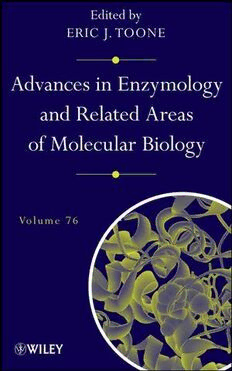
Advances in Enzymology and Related Areas of Molecular Biology: And Related Areas of Molecular Biology, Volume 76 PDF
Preview Advances in Enzymology and Related Areas of Molecular Biology: And Related Areas of Molecular Biology, Volume 76
ADVANCES IN ENZYMOLOGY ANDRELATEDAREASOF MOLECULARBIOLOGY Volume76 ADVANCES IN ENZYMOLOGY AND RELATEDAREAS OF MOLECULAR BIOLOGY Edited by ERIC J. TOONE DUKE UNIVERSITY, DURHAM, NORTH CAROLINA VOLUME76 Copyright(cid:1)2009byJohnWiley&Sons,Inc.Allrightsreserved. PublishedbyJohnWiley&Sons,Inc.,Hoboken,NewJersey PublishedsimultaneouslyinCanada Nopartofthispublicationmaybereproduced,storedinaretrievalsystem,ortransmittedin anyformorbyanymeans,electronic,mechanical,photocopying,recording,scanning,or otherwise,exceptaspermittedunderSection107or108ofthe1976UnitedStatesCopyright Act,withouteitherthepriorwrittenpermissionofthePublisher,orauthorizationthrough paymentoftheappropriateper-copyfeetotheCopyrightClearanceCenter,Inc.,222Rosewood Drive,Danvers,MA01923,978-750-8400,fax978-750-4470,oronthewebatwww.copyright. com.RequeststothePublisherforpermissionshouldbeaddressedtothePermissions Department,JohnWiley&Sons,Inc.,111RiverStreet,Hoboken,NJ07030,201-748-6011, fax201-748-6008,oronlineathttp://www.wiley.com/go/permission. LimitofLiability/DisclaimerofWarranty:Whilethepublisherandauthorhaveusedtheirbest effortsinpreparingthisbook,theymakenorepresentationsorwarrantieswithrespectto theaccuracyorcompletenessofthecontentsofthisbookandspecificallydisclaimany impliedwarrantiesofmerchantabilityorfitnessforaparticularpurpose.Nowarrantymay becreatedorextendedbysalesrepresentativesorwrittensalesmaterials.Theadviceand strategiescontainedhereinmaynotbesuitableforyoursituation.Youshouldconsultwitha professionalwhereappropriate.Neitherthepublishernorauthorshallbeliableforanyloss ofprofitoranyothercommercialdamages,includingbutnotlimitedtospecial,incidental, consequential,orotherdamages. Forgeneralinformationonourotherproductsandservicesorfortechnicalsupport,please contactourCustomerCareDepartmentwithintheUnitedStatesat877-762-2974,outsidethe UnitedStatesat317-572-3993orfax317-572-4002. Wileyalsopublishesitsbooksinavarietyofelectronicformats.Somecontentthatappears inprintmaynotbeavailableinelectronicformats.FormoreinformationaboutWileyproducts, visitourwebsiteatwww.wiley.com. LibraryofCongressCataloging-in-PublicationData: ISBN978-0471-23584-2 PrintedintheUnitedStatesofAmerica 10987654321 CONTENTS Contributors .. . . .. . . .. . .. . . .. . . .. . . .. . . .. . .. . . .. . . . vii Preface.. . . .. . . .. . . .. . .. . . .. . . .. . . .. . . .. . .. . . .. . . . ix Inosine 50-Monophosphate Dehydrogenase. .. . . .. . .. . . .. . . . 1 Maxim Pimkin and GeorgeD. Markham Natural ProductGlycosyltransferases: Properties andApplications . .. . .. . . .. . . .. . . .. . . .. . .. . . .. . . . 55 Gavin J. Williamsand Jon S. Thorson Combinatorial andEvolutionary Design of Biosynthetic Reaction Sequences . . .. . . .. . . .. . . .. . . .. . .. . . .. . . 121 Ethan T. Johnson, Erik Holtzapple, and Claudia Schmidt-Dannert Trends inMicrobial Synthesis ofNatural Products andBiofuels. .. . . .. . . .. . . .. . . .. . .. . . .. . . 151 Joseph A. Chemier,Zachary L. Fowler, MattheosA. G.Koffas, andEffendiLeonard Author Index.. . . .. . . .. . .. . . .. . . .. . . .. . . .. . .. . . .. . . 219 Subject Index . . . .. . . .. . .. . . .. . . .. . . .. . . .. . .. . . .. . . 243 v CONTRIBUTORS JOSEPHA.CHEMIER, DepartmentofChemicalandBiologicalEngineering,University ofBuffalo,303FumasHall,Buffalo,NY14260 ZACHARY L. FOWLER, Department of Chemical and Biological Engineering, UniversityofBuffalo,303FumasHall,Buffalo,NY14260 ERIKHOLTZAPPLE, DepartmentofBiochemistry,MolecularBiologyandBiophysics, UniversityofMinnesota,1479GortnerAvenue,St.Paul,MN55108 ETHANT.JOHNSON, DepartmentofBiochemistry,MolecularBiologyandBiophysics, UniversityofMinnesota,1479GortnerAvenue,St.Paul,MN55108 *MATTHEOS A. G. KOFFAS, Department of Chemical and Biological Engineering, UniversityofBuffalo,303FumasHall,Buffalo,NY14260 [email:[email protected]] EFFENDILEONARD, DepartmentofChemicalEngineering,MassachusettsInstituteof Technology,77MassachusettsAvenue,Amherst,MA02139 *GEORGED.MARKHAM, TheFoxChaseCancerCenter,InstituteforCancerResearch, 333CottmanAvenue,Philadelphia,PA19111[email:[email protected]] MAXIMPIMKIN, TheFoxChaseCancerCenter,InstituteforCancerResearch,333 CottmanAvenue,Philadelphia,PA19111 *CLAUDIASCHMIDT-DANNERT, DepartmentofBiochemistry,MolecularBiologyand Biophysics,UniversityofMinnesota,1479GortnerAvenue,St.Paul,MN55108 [email:[email protected]] *JONS.THORSON, LaboratoryforBiosyntheticChemistry,PharmaceuticalSciences Division,SchoolofPharmacy,NationalCooperativeDrugDiscoveryProgram, UniversityofWisconsin—Madison,777HighlandAvenue,Madison,WI53705 [email:[email protected]] GAVIN J. WILLIAMS, Laboratory for Biosynthetic Chemistry, Pharmaceutical SciencesDivision,SchoolofPharmacy,NationalCooperativeDrugDiscovery Program,UniversityofWisconsin—Madison,777HighlandAvenue,Madison, WI53705 *Correspondingauthor. vii PREFACE Naturalproducts continue toplay animportant roleinthe treatmentof human disease. Among the most daunting limitations to the use of such speciesistheneedforsyntheticapproachestothesignificantquantitiesof material needed for biochemical study, preclinical and clinical evaluation and,ultimately,supply.Althoughsyntheticchemistryhasmadetremendous advancesinenantiopuresynthesis,materiallimitationsstillloomlargeinthe developmentofnatural product therapeutics. Enzymesarebynowwellestablishedaschiralcatalystsfortheconstruc- tion of small chiral synthons, and the use of various esterases, lipases, oxidoreductases,andotherenzymesiswellknownbothfortheresolutionof racemates and for the desymmetrization of optically inactive meso com- pounds. But the construction of complex natural products often requires dozens of transformations beginning from such simple starting materials. Complex materials are constructed in vivo through multiple sequential enzymatictransformations,producingproductsofstartlingcomplexitywith apparent ease. The development of novel in vivo biosynthetic pathways mighteasethemateriallimitationsfordrugdevelopment:theconstruction and use of such pathways forms the focus of this volume of Advances in Enzymology. A surprising number of biosynthetic pathways are modular, creating a diversity of products by subtle rearrangement of genes. This modular approach to natural product biosynthesis provides a potentially powerful approach to the construction of large numbers of related complexnatural productsandtothepreparationonscaleofsinglecompounds.Twochapters in this volume, by Claudia Schmidt-Dannert and coworkers and by Mat- theos Koffas and coworkers, review various aspects of such approaches. Glycosylation is increasingly recognized as a powerful modulator of the biological activities of complex natural products, both with regards to biologicallifetimesandaffinityandavidityatthetargetreceptor.Chemi- cal glycosylation is notoriously refractive, and in vivo approaches to glycosylation are especially attractive: the use of native and engineered ix x PREFACE glycosyltransferasesforthepreparationofglycosylatednaturalproductsis described here by Williams and Thorson. Finally, Pimkin and Markham describethestructure,activityandinhibitionofthenicotinamide-dependent inosine-50-monophosphate dehydrogenase. ERIC J. TOONE Figure1.4. StructuresofIMPDH.(Seetextforfulldescription.) Figure1.6. IMPDHconformationalflexibility.Superpositionofa-carbontracesofmonomer coredomainsindifferentstructures.(A)Structuralflexibilityoftheactive-siteloopandactive- siteflap.Superimpositionoftheentirecoredomainsof1jr1,1b3o,1eep,1zfj,1ak5,and1pvn. ThesubstrateIMPofS.pyogenesstructure(1zfj)isshowninCPK-coloredstickrepresentation. The1zfjactive-siteCysisshownasaCPK-coloredspace-fillmodel.(B)Changeintheactive- siteloop6conformationupon6-Cl-IMPbinding.Superimpositionoftheentirecoredomainsof 1nfb,1zfj,and1jr1.TheIMPsubstrateof1zfjandthe6-Cl-IMPadductareshowninstick representation.(C)PositionoftheCBSsubdomainindifferentIMPDHstructuresrelativetothe enzyme core domain. The substrate IMP of 1zfj structure is illustrated in red space-fill representation.Thehumantype2structureisingold(1b3o),thehamsterstructureindark blue(1jr1),theS.pyogenes(1zfj)structureingreen,theB.burgdorferistructure(1eep)ingrey, theT.foetusapoenzymestructureinmagenta(1ak5),thehumantype2structureincomplexwith (cid:1) 6-Cl-IMPandNADinred,andtheT.foetusEMMPcomplexincyan(1pvn).UCSFChimera (36a)wasusedforthecoordinatesuperpositionandstructurevisualization. Figure1.7. StereoviewofthetransitionstateanalogyofMMPinT.foetusstructure(1pvn)and mechanismofwateractivation.Thedistancesareindicatedwithdottedlines. Figure1.9. PlausiblestructuraldynamicsoftheIMPDHcatalyticcycle.Theactive-siteloop6 andtheflapappeartoberelativelydisorderedintheabsenceofsubstrates.BindingofIMP causes a conformational change in the loop; the flap remainslargely disordered.After the hydridetransferiscomplete,NADHdissociatesandtheflapmovesintotheNADsite,activating waterandconvertingtheenzymetoahydrolase.
